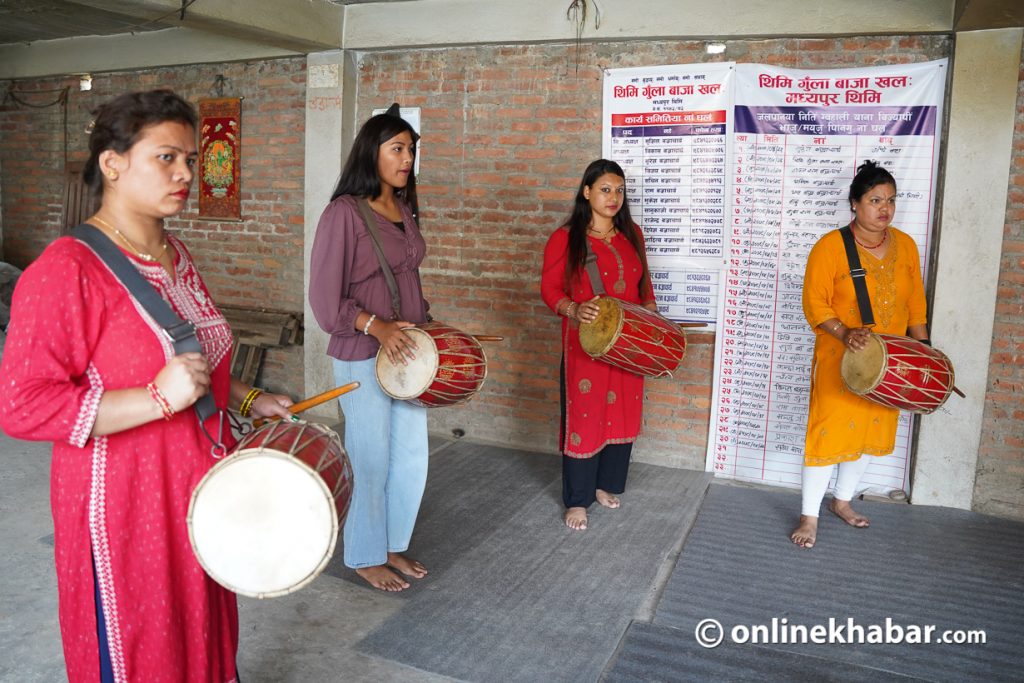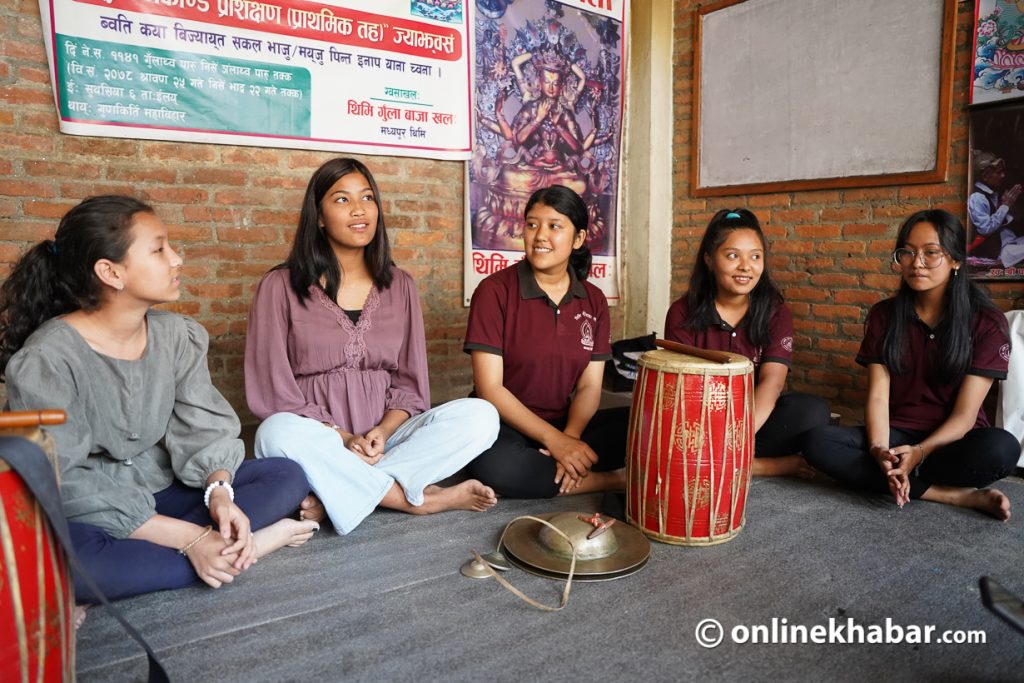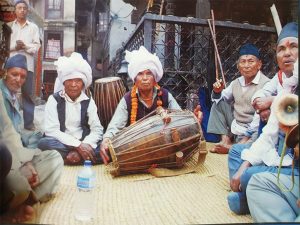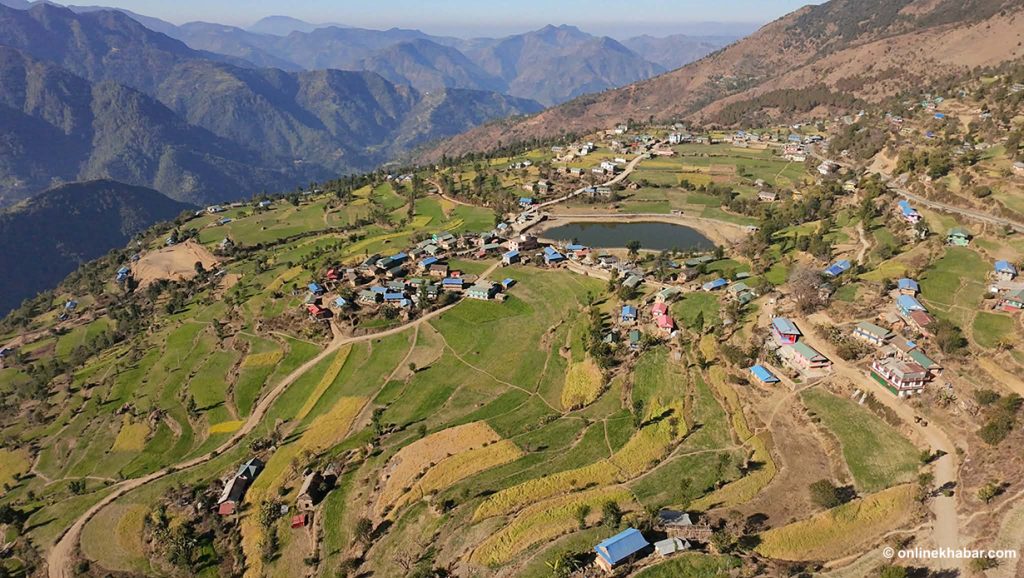
Walking some five minutes uphill from the Madhyapur Thimi road in Bhaktapur, one can hear music reverbing out from a building under construction. The Digu Bahal, though in shambles, is the place where the people gather to practice for Gunlaa. People of the Bajracharya clan in the area gather together and then practise Gunlaa baaja for the upcoming Gunlaa, a month-long festival marked by the Newa community in Nepal.
In unison, they strike the sides of naaya khin or dha (a double-sided drum) with their hands and a stick in their left hand. In one corner, one plays taa (a pair of small cymbals) and another person plays chhusyaa (a pair of cymbals). Starting Friday, they will now visit the bahas and bahis of the Thimi area, play Gunlaa baaja, and pay their respects to the gods.
While the field is historically dominated by men, you can see women playing Gunlaa baaja side-by-side with their male counterparts without any restrictions in Thimi of Bhaktapur. Women playing various musical instruments is a feat that was only recently seen in Kathmandu, in Thimi, they started playing them some two decades ago.
New-age thinking

While issues of women empowerment and gender equality have taken a leap in this modern world, many women in Nepal are still barred from and criticised for playing musical instruments. Because people believe that the musical instruments are an incarnation of god, women were kept away and barred from touching or playing them believing menstruation makes them impure.
However, Kathmandu has recently started witnessing some women and girls playing traditional musical instruments. But, according to Sushil Bajracharya, the immediate past president of Thimi Gunlaa Baaja Khala, the female members of their khala (a local group) were encouraged to play since around 20 years ago though they too realised the importance much late.
“Our khala has a written history from Nepal Sambat 1047, about 95 years now, But, our forefather Harka Ratna Bajracharya is known to have started the khala much before that. In this century-long history, women were only known to have learned to play some 20 years ago although it was encouraged by a generation or two before us.”
The first female batch included only five women. Minu Buddhacharya (33) shares, “We used to see the men and boys playing the musical instruments during Gunlaa. The lively music used to make us feel like dancing and we always wanted to learn that too. When we expressed that we wanted to learn in the family, we were encouraged and then we found a teacher in the khala, so we learned and played in the Gunlaa.”
But, she and her batchmates stopped playing after they got married and migrated. “But, when we visit our parents during Gunlaa, we are encouraged to play and be a part of the musical celebration.”
The first batch had no one to look up to and they got into learning the musical instruments late. But, now they are being the torchbearers for the next generation. Sanu Bajracharya (40) is now encouraging her 12-year-old daughter Rojisha to learn Gunlaa baaja. “Starting this year, she is now here learning the instruments. She learns with the teacher at the khala and, at home, I practise with her.”
One of the music teachers in the khala, Ananda Bajracharya, adds, “Nowadays, it is easier to teach as well. People now can record the classes and then practise at home with ease.” Rojisha has already learned the taals taught to them in this one-month time and is all ready to join them in the Gunlaa baaja procession starting this year.
Breaking the barriers
At Thimi, today, it is a common sight to see women play during Gunlaa. They go to nine bihars every day starting at 6 am and tour the Thimi area along the various Hindu and Buddhist shrines there. At weekends, they also visit Hindu and Buddhist shrines of Kathmandu including Swaymbhu and Boudhha.

When the female music players first toured Thimi, Rojita Bajracharya (28) remembers how people reacted. “It might have been an unusual sight, but the people were very positive towards us playing. They would encourage us more and then praise us for being a part of the musical group too.”
Bikash Bajracharya, the president of the khala, says the group has been encouraging women despite their low participation sometimes. “There was a time when the number of music players had dipped low. At that time, the musical instruments were handed over to the households, in rotation. When that happened, the women and girls of the households showed interest to learn. Given the decreasing number of the players, the generation before us included women too.”
But, Sushil adds that women and girls have never been barred from learning. “The unconscious social construct might have discouraged them, but our scriptures never stopped women from learning.”
Yet, he says, “Generally, the Gunlaa Baaja Khala is associated with the bihars where exists a practice called Prawajit (the cultural practice of induction) in the bihars. Those not inducted are not allowed to participate in the bihar’s work nor learn the musical instruments.”
“Since women were not usually through this ritual, they were not allowed to play the Gunlaa baaja either,” he adds.
“However, since our khala is not associated with any bihars, we do not need to follow that practice and it became much easier for women to get involved too. But, it is not to say that women never undergo the ritual, just that it is low in numbers,” he clarifies.
After 2015, he informs, the new generation of leaders including him institutionalised the khala. “Before that, it was operated by a guthi (a local institution formed for social or religious practices). After 2015, we changed the operational setting, set up an executive committee and encouraged the female younger generation to learn Gunlaa baaja.”
Inter-generational transformation

Sumina Bajracharya (19) started learning Gunlaa baaja in 2015. “I had seen my father and brother learning and I got interested too. But, seeing women play was still few and far between.”
After the first female batch got married, she says, there was a gap in the area where women were not playing the instruments. She noticed there was just a handful of women learning and playing the traditional musical instruments.
“The low number made me wonder if the women are not allowed or if they did not get the opportunity. But, the khala gave the women before us and our batch the opportunity to learn. And, hopefully, the newer generation will also get encouraged to learn Gunlaa baaja, seeing us.”
Regardless, women not being “allowed” to play musical instruments was news to her. “It is about the skill. So, not allowing women to learn should not be the norm. Both the sexes should be allowed to learn and play.” She shares she is willing to learn other musical instruments too.
In the last seven years, Sumina has not just learned playing but is also actively teaching new learners like Rojisha. “We start from the taals and the beats. And, slowly, we progress to learning the long and complex routines.”
The group president Bikash, however, is worried about the future. “We are teaching the younger generation. But, so far, we are encouraging our daughters only. Soon, just like before, when they get married, they will go elsewhere and we might see fewer female players again.”
“But, again, we are now thinking of teaching our daughters-in-law about Gunlaa baaja. Maybe, we can start it next year.”


























